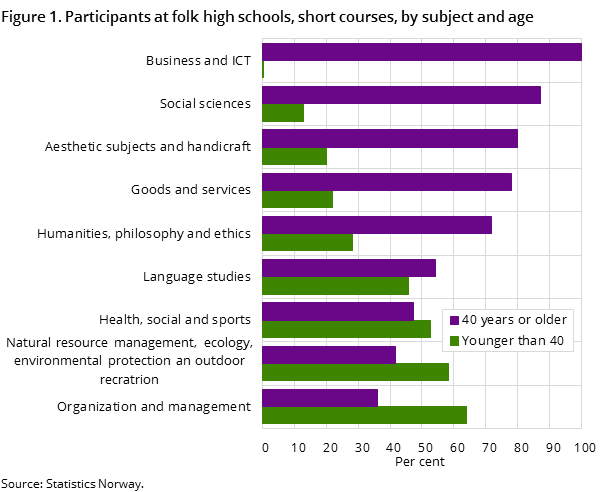Content
Published:
Age affects the choice of subject
Approximately 17 700 participants took part in short courses at folk high schools in 2014, with the majority attending aesthetic subjects and handicraft. Among these participants, eight out of ten were aged 40 years or older. The figures show that the participants’ age affects their choice of subject.
| Total | Per cent | ||
|---|---|---|---|
| 2014 | 2013 - 2014 | 2011 - 2014 | |
| Total | 17 714 | -4.0 | -7.0 |
| Males | |||
| 19 year or younger | 569 | 6.4 | 2.9 |
| 20-29 years | 983 | -4.4 | 3.3 |
| 30-39 years | 536 | -20.5 | -10.4 |
| 40-49 years | 815 | -17.8 | -3.3 |
| 50 years or older | 3 497 | -9.1 | -11.2 |
| Females | |||
| 19 year or younger | 784 | 0.3 | 3.6 |
| 20-29 years | 1 394 | 4.7 | 18.4 |
| 30-39 years | 974 | -1.7 | 6.8 |
| 40-49 years | 1 756 | -5.8 | 3.5 |
| 50 years or older | 6 406 | 0.0 | 1.7 |

The most popular short courses at folk high schools, among both women and men, were aesthetic subjects and handicraft, which had about 6 300 participants, followed by courses in social sciences; humanities, philosophy and ethics; and health, social and sports subjects. The age of participants seems to affect the choice of subject. For example, 64 per cent of those who chose courses related to organisation and management are younger participants (16-39 years), while all participants on business and ICT courses are aged 40 years or over.
The majority of participants are women, making up 64 per cent of all participants. Since 2013, the number of male participants has decreased by 700, while the number of women has not changed significantly over time.
With respect to age and gender, the largest group of short course participants is made up of women within the age group 50 years and over – 36 per cent. There are also many male participants in the same age group – about 20 per cent, but their numbers have decreased by 800 over the last two years. At the same time, there has been a slight reduction in male participants as a whole.
In 2014, the number of foreign participants on short courses was about 1 100. Compared to the previous year, this is a reduction of 18 per cent within this group. Even though there were 400 fewer participants from Sweden, they still make up the largest group of foreign participants. The second largest group of foreign participants is from Russia, while the third is from Denmark. The group with Danish participants has increased the most since 2013.
Contact
-
Maja Kalcic
E-mail: maja.kalcic@ssb.no
tel.: (+47) 48 19 72 40
-
Rachel Ekren
E-mail: rachel.ekren@ssb.no
tel.: (+47) 95 83 89 67
